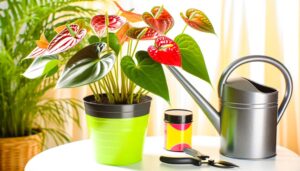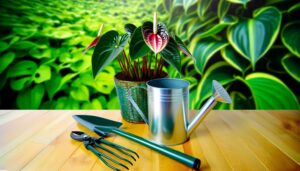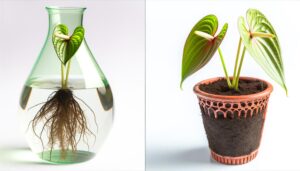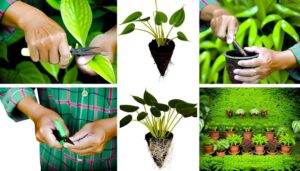Master Anthurium Chonk Propagation in 10 Steps
Master Anthurium chonk propagation by following these 10 precise steps. First, gather sterilized pruning shears, rooting hormone, and a well-draining potting mix.
Choose a healthy chonk with nodes and aerial roots. Sanitize your tools with isopropyl alcohol and make a clean cut with one node per segment.
Plant the chonk in a mix containing orchid bark, perlite, and peat moss. Place it in bright, indirect sunlight and maintain ideal humidity.
Monitor daily for new growth and prune any unhealthy sections. Maintain conditions similar to a tropical habitat for success.
Access detailed mastery by continuing with this guide.
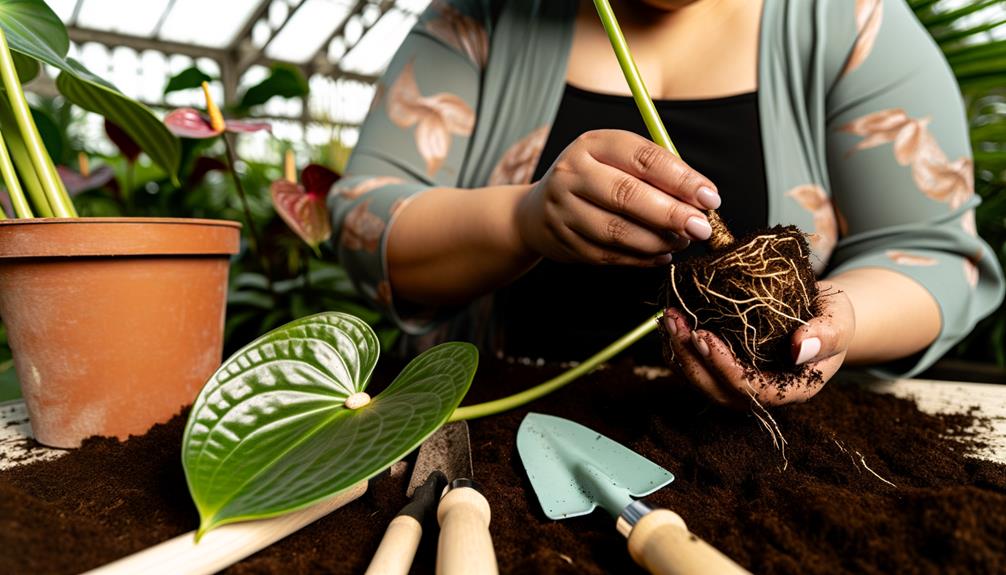
Key Takeaways
- Use sterilized pruning shears to take clean cuts, ensuring one node per segment for optimal propagation.
- Dip cut segments in rooting hormone and plant in a well-draining mix of orchid bark, perlite, and peat moss.
- Place planted chonks in bright, indirect sunlight near east or north-facing windows or under full-spectrum LED grow lights.
- Maintain high humidity and temperatures similar to tropical conditions, monitoring for signs of fungal issues.
- Inspect daily for new growth, using a magnifying glass to detect early root hairs, and prune unhealthy sections promptly.
Gather Your Materials
Before you start propagating your Anthurium chonk, make sure you have necessary materials including sterilized pruning shears, a clean cutting surface, rooting hormone, and a suitable potting mix.
Sterilize your pruning shears using isopropyl alcohol to prevent pathogen transmission. Your cutting surface should be sanitized to maintain a sterile environment, minimizing contamination risk.
Utilize rooting hormone to encourage root development by dipping the cut end of the chonk into the hormone powder. Select a well-draining potting mix, comprising equal parts of perlite, orchid bark, and peat moss, to ensure best aeration and moisture retention.
These materials are vital for a successful propagation process, reducing the likelihood of rot and promoting healthy root growth.
Choose the Right Chonk
Now that you've gathered your materials, identify a healthy, mature chonk with at least one node and a few aerial roots to guarantee successful propagation.
Examine the chonk for signs of vigor: firm texture, vibrant green hue, and absence of pests or disease. The node, a small swelling on the stem, is essential as it contains the meristematic tissue necessary for new growth. Aerial roots, protruding from the chonk, enhance nutrient uptake and stability.
Avoid chonks that appear shriveled, brown, or mushy as they indicate poor health. Use a sterilized tool to separate the chosen chonk, ensuring a clean cut to prevent infection.
This careful selection process ensures the highest likelihood of thriving anthurium offspring.
Prepare the Cutting Area
Sanitize your workspace with a disinfectant solution to minimize the risk of contaminating the chonk during the cutting process. Use a diluted bleach solution (1 part bleach to 9 parts water) or a commercial disinfectant. Wipe down all surfaces, making sure that any organic material or debris is removed. This step is essential to prevent the introduction of pathogens that could compromise the health of your Anthurium chonk.
Next, place a clean, sterilized cutting mat or board on your sanitized surface. Ensure adequate lighting to clearly see the chonk and any cuts you make. Keep a waste receptacle nearby for easy disposal of plant material.
Sanitize Your Tools
With your cutting area prepared, make sure your tools are sanitized to avoid introducing pathogens to the chonk.
First, gather your pruning shears, knives, or scalpels. Use a 70% isopropyl alcohol solution or a 10% bleach solution for disinfection. Submerge the tools in the solution for at least 30 seconds. Alternatively, you can wipe them thoroughly, ensuring all cutting surfaces are covered.
After sanitizing, let the tools air dry on a clean, sterile surface. This step is essential to prevent bacterial or fungal infections that could compromise the health of your anthurium chonk.
Regularly sanitize your tools between cuts to maintain a sterile environment. Proper sanitation practices will greatly increase the success rate of your propagation efforts.
Make the Cut
Position the sanitized tools at a 45-degree angle to the chonk, making sure a clean and precise cut. This angle maximizes the surface area, promoting best root development.
With steady hands, make a single, swift incision through the chonk, avoiding jagged edges which can hinder healing. Verify that each cut segment has at least one node and an aerial root for successful propagation. Nodes are important as they contain meristematic cells, vital for new growth.
Inspect your cuts for any signs of disease or rot, discarding any compromised sections. Cleanliness and precision are crucial to prevent infection and ensure strong propagation.
Your meticulous technique here sets the foundation for healthy anthurium plants.
Apply Rooting Hormone
Applying rooting hormone is essential for stimulating root development in your Anthurium chonk cuttings. You'll benefit from enhanced root growth, reduced propagation time, and increased success rates.
Use a sterile brush to coat the cut end with a thin layer of rooting hormone, adhering to best practices to avoid contamination and guarantee uniform application.
Benefits of Rooting Hormone
Using rooting hormone significantly enhances the success rate of anthurium chonk propagation by accelerating root development and improving overall plant health. The hormone contains auxins, which are plant growth regulators that stimulate root cell elongation and differentiation. When you apply it to your anthurium chonk, you're essentially giving it a biochemical boost to develop a robust root system more rapidly.
Rooting hormone lessens the risk of fungal infections and reduces transplant shock. It's particularly effective in overcoming the plant's natural dormancy periods, ensuring continuous growth. Additionally, it boosts nutrient uptake efficiency, leading to healthier, more vigorous plants.
Application Techniques Explained
To effectively harness the benefits of rooting hormone, start by selecting a high-quality product and preparing your anthurium chonk for application.
First, trim any damaged or decayed parts of the chonk with sterilized pruning shears to prevent infection. Once the chonk is ready, follow these steps:
- Dip the cut end: Immerse the cut end of the chonk into the rooting hormone powder or gel, ensuring even coverage.
- Shake off excess: Lightly tap the chonk to remove any excess rooting hormone, avoiding clumping which can hinder root development.
- Plant immediately: Insert the treated chonk into your prepared growing medium, maintaining consistent moisture and temperature conditions.
Best Practices Overview
Wondering how to maximize the effectiveness of rooting hormone for your anthurium chonk propagation? Begin by confirming your chonk is clean and free from debris. Dip the cut end into the rooting hormone powder, ensuring uniform coverage. Tap off excess powder to avoid clumping. Place the treated end into a pre-moistened, sterile propagation medium.
| Step | Description |
|---|---|
| Clean Chonk | Remove any debris and confirm a clean cut surface. |
| Apply Hormone | Dip cut end into rooting hormone, covering evenly. |
| Plant Chonk | Insert treated end into moistened, sterile medium. |
Maintain high humidity and indirect light. Monitor moisture levels and mist as needed. The hormone enhances root development by stimulating cell differentiation and growth, optimizing your propagation success.
Select the Growing Medium
Selecting the finest growing medium is crucial for successful Anthurium chonk propagation, as it secures proper aeration, moisture retention, and nutrient availability. You need a medium that mimics their natural epiphytic environment, guaranteeing roots can breathe and avoid decay.
Here's a scientifically sound mix:
- Orchid Bark: Boosts aeration and prevents compaction.
- Perlite: Enhances drainage and maintains necessary moisture without waterlogging.
- Sphagnum Moss: Retains moisture and offers a stable, nutrient-rich base.
Mix these components in a 1:1:1 ratio.
Ensure the medium is sterile to prevent pathogen introduction.
This combination supports prime root development and promotes healthy growth.
Keep the medium slightly moist but never waterlogged, as excess water can lead to root decay.
Plant the Chonk
Gently place the Anthurium chonk into the prepared growing medium, making sure the node is slightly covered while keeping the aerial roots exposed for best aeration.
Position the chonk horizontally, allowing the node to make contact with the medium, which should be a mix of sphagnum moss, orchid bark, and perlite. This combination guarantees ideal moisture retention and drainage.
Firmly press the medium around the node to stabilize the chonk without compressing it, which could impede root development. Make sure that the aerial roots remain above the medium to facilitate gas exchange.
Mist the chonk lightly with water to maintain humidity, initiating the root growth process. This careful positioning and preparation will promote healthy root establishment and vigorous plant development.
Maintain Ideal Conditions
To maximize the health of your Anthurium chonk, provide ideal light levels by placing it in bright, indirect sunlight.
Maintain a temperature range of 70-85°F and humidity levels around 70-80%.
Use a well-draining soil mix composed of orchid bark, perlite, and peat moss to promote healthy root development.
Optimal Light Levels
Securing ideal light levels for Anthurium chonk propagation involves providing bright, indirect sunlight to promote healthy growth and prevent leaf scorch. Anthuriums thrive under conditions that mimic their natural tropical habitat. Direct sunlight can cause photodamage, leading to chlorosis and necrosis.
To achieve prime light exposure, follow these detailed steps:
- Placement: Position your Anthurium near an east or north-facing window to make sure it receives soft, diffused light.
- Artificial Lighting: Use full-spectrum LED grow lights if natural light is insufficient, maintaining a photoperiod of 12-14 hours daily.
- Light Intensity: Measure light intensity with a lux meter, aiming for 10,000-20,000 lux, which aligns with their natural understory environment.
These measures will promote robust and healthy Anthurium growth.
Temperature and Humidity
Maintaining ideal light levels is just one aspect; ensuring appropriate temperature and humidity is equally essential for successful Anthurium chonk propagation.
Aim for a consistent temperature range of 70-85°F (21-29°C). Temperatures below 60°F (15°C) can stunt growth or cause damage.
Humidity should be kept between 70-80% to mimic their native tropical environment. Use a hygrometer to monitor humidity levels and employ humidifiers or humidity trays if necessary.
Avoid placing your Anthurium near drafts, heating vents, or air conditioners, as these can create fluctuations detrimental to growth. Regular misting can help maintain proper humidity, but don't overdo it to avoid fungal issues.
Proper Soil Mix
When preparing the soil mix for Anthurium chonk propagation, you'll need a well-draining medium rich in organic matter to facilitate proper root aeration and moisture retention. Achieving the ideal balance involves meticulous selection of components.
- Orchid Bark: Provides excellent drainage and prevents root rot.
- Perlite: Enhances aeration and drainage, guaranteeing roots receive adequate oxygen.
- Peat Moss: Retains moisture while maintaining a slightly acidic pH, ideal for Anthuriums.
Thoroughly combine these components to create a medium that supports robust root development.
The right soil mix guarantees your Anthurium chonk can thrive, promoting healthy growth and successful propagation.
Maintain vigilance in soil moisture levels to avoid overwatering, which can lead to root rot and other issues.
Monitor New Growth
Closely monitor the development of new shoots and roots to guarantee the Anthurium chonk is progressing healthily. Inspect daily for emerging growth points and root elongation.
Utilize a magnifying glass to detect early signs of root hairs, indicative of successful propagation. Sustain adequate light levels, around 700-1000 foot-candles, and maintain a consistent humidity of 70-80%.
If new growth appears stunted or discolored, reassess environmental variables such as substrate moisture and ambient temperature, ideally 75-85°F. Document growth stages with photos and notes to track progress accurately.
Prune any unhealthy sections to prevent disease spread. By vigilantly monitoring these factors, you'll secure robust development and a thriving Anthurium chonk.
Conclusion
You've just discovered the secret to becoming an Anthurium propagation wizard. With your newfound skills, you'll soon have a jungle of vibrant chonks flourishing in every corner of your home.
Remember, meticulous care and precision are your allies in this botanical adventure.
So, go ahead, revel in your green-thumb glory, and watch as your Anthurium collection becomes the envy of plant enthusiasts everywhere.
You're not just growing plants; you're mastering botanical sorcery!


